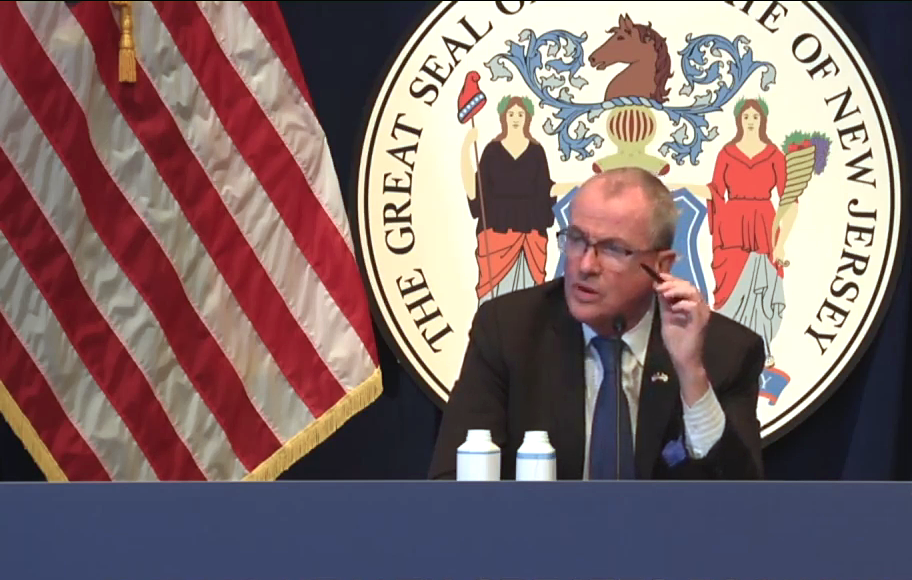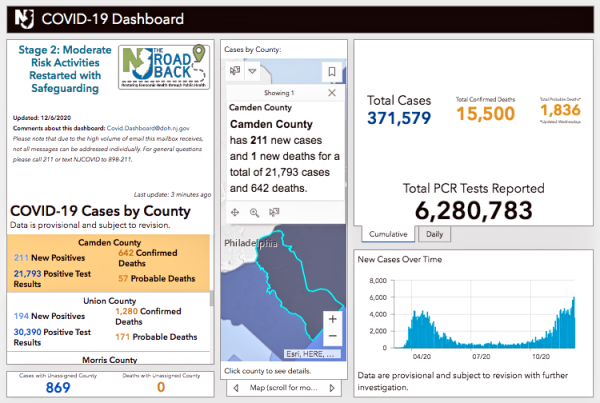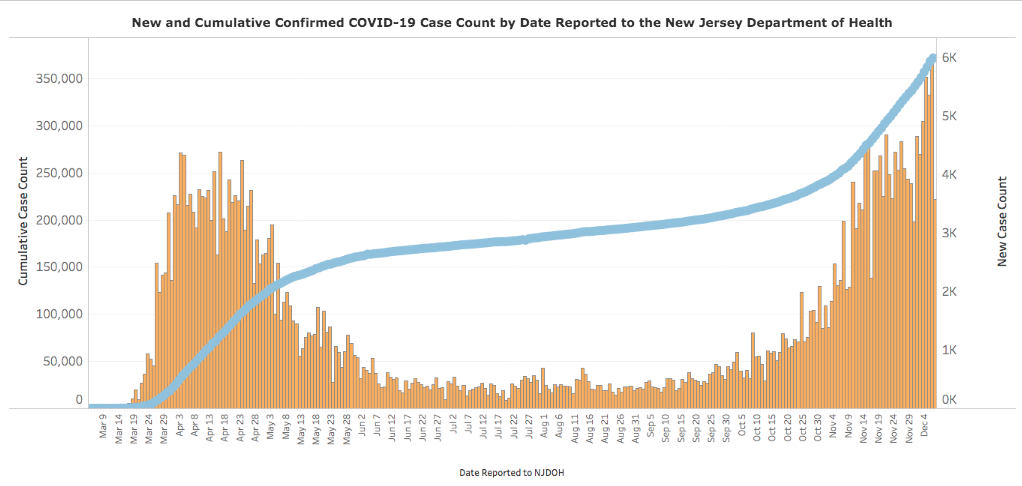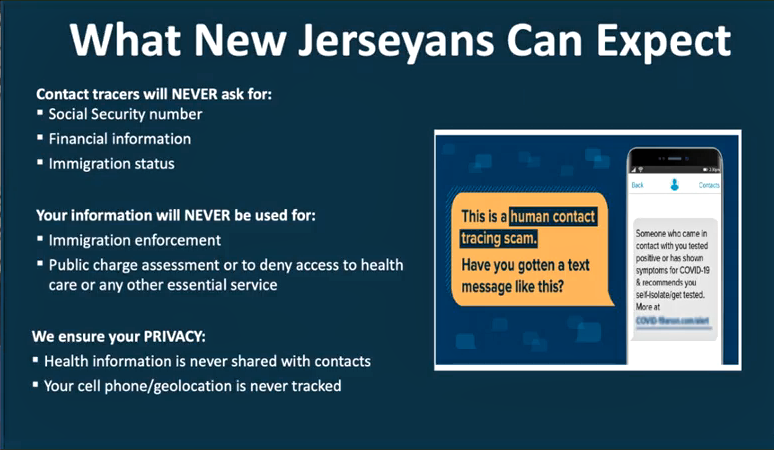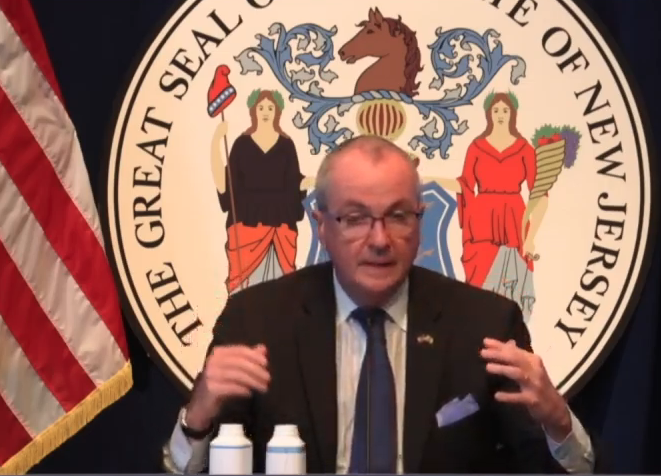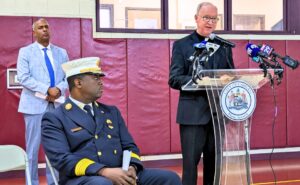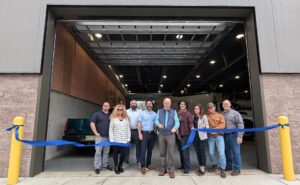Nearly three-quarters of all people called by a New Jersey contact tracer refuse to cooperate with the process, Gov. Phil Murphy says. Plus: NJ Health Department guidance for holiday gatherings.
By Matt Skoufalos | December 7, 2020
Another 3,573 New Jersey residents have tested positive for novel coronavirus (COVID-19), bringing the statewide total to 371,579 cases, Governor Phil Murphy reported Monday.
Sadly, 17 more residents have perished from complications related to the virus, bringing the statewide death toll to 15,500 lives lost during the pandemic.
In addition to those lab-confirmed fatalities, the state has acknowledged another 1,836 probable COVID-19-related deaths.
Since March, 483 of every 100,000 New Jersey residents have been hospitalized with COVID-19, and 176 of every 100,000 have died from COVID-19-related complications.
More than 6.28 million polymerase chain reaction (PCR) tests for COVID-19 have been performed statewide, with a 4.18-percent positivity rate per 100,000 residents.
Rate of transmission (Rt) at 1.05, spot positivity highest in South Jersey
The statewide average of COVID-19 spot positivity testing stood at 11.4 percent December 3; in South Jersey, it was highest, at 15.08 percent.
Rt, the variable that describes the seven-day, rolling-average, statewide rate of transmission of new COVID-19 cases, fell to 1.05 from samples taken December 5.
An Rt figure greater than 1.0 means that each new COVID-19 patient is infecting more than one other person, on average, and the spread of the virus is increasing.
Since its mid-April COVID-19 spike, the highest reported RT in New Jersey was 1.48, recorded August 1. The lowest was 0.62, recorded June 9.
Hospitalizations continue to follow new infections
Throughout New Jersey, 3,346 people currently are hospitalized with a suspected (236) or confirmed (3,110) case of COVID-19, Murphy said.
Yesterday 417 COVID-positive patients were admitted to New Jersey hospitals, while 269 were discharged.
Among those hospitalized patients, 637 were in intensive or critical care, and 391 of the ICU and critical-care patients (61 percent) are on ventilators.
Across the state, long-term care (LTC) centers have reported 1,068 cumulative outbreaks of COVID-19, and 377 are dealing with an active outbreak. LTCs account for 44,032 infected patients and staff in New Jersey, or 12 percent of total cases.
That includes 27,416 residents and 16,616 staffers sickened by the virus, as well as 7,337 lab-confirmed resident and staff deaths (48 percent of the statewide total), with facilities self-reporting 122 staff deaths.
Of 656 veterans residing in three state-run homes, 410 residents have tested positive for COVID-19, and 147 have died from complications related to the virus. Nine veterans presently are hospitalized with COVID-19, and 250 have recovered from the virus.
At state-run psychiatric facilities, 266 of 1,172 patients and 684 staff members have tested positive for COVID-19. Fourteen patients and seven staffers have died from complications related to the virus.
To date, 63 New Jersey children aged 1 to 18 have been diagnosed with pediatric multisystem inflammatory syndrome.
All those pediatric patients have tested positive for an active COVID-19 infection or the presence of COVID-19 antibodies, indicating exposure to the virus. No deaths have been associated with this syndrome in New Jersey, although several children have been hospitalized during their treatment.
Since August 1, 70 COVID-19 outbreaks encompassing 285 individual cases have been traced to schools in 18 New Jersey counties. In Camden County, 10 outbreaks have been linked to 57 cases. That’s the most in the state.
NJ single-day high in new infections believed to be directly related to Thanksgiving holiday gatherings
On Sunday, New Jersey recorded a pandemic single-day high of 6,046 new COVID-19 infections.
Dr. Ed Lifshitz, who directs the state communicable disease service, said that although officials can’t definitively connect the Thanksgiving holiday with the uptick in new infections, all the evidence is leaning in that direction thus far.
“Holidays disrupt the normal flow of individuals seeking, providers offering, and laboratories analyzing tests, making direct comparisons of case counts between days difficult,” Lifshitz said.
“Given the lag between infection, illness onset testing, and reporting of results, full effects as it relates to case counts will not be expected to be known for several days,” he said, adding, “however, it is clear that New Jersey’s cases continue to trend up.”
Lifshitz urged residents to limit any subsequent indoor holiday gatherings to immediate household members, and to avoid intergenerational gatherings. He advised that people avoid sharing “commonly touched items,” not establish buffets and drink stations, and keep seating socially distant. Guests should also wear masks when not eating and drinking.
The doctor also offered remarks about pandemic fatigue, saying that he’s “really not crazy about wearing a mask,” and is bothered by the impact of the adjustments his family has had to make to their “athletic, academic, social, and professional lives” to keep safe.
“I really don’t like what it’s doing to my neighbors and community, the disruption of family and social life, especially during this holiday season, and the economic pain that is apparent as businesses falter,” Lifshitz said.
“But what I really hate is thinking about the families of more than 15,000 New Jerseyans who have died,” he concluded.
New Jerseyans continue to spurn contact tracers
Despite having reached its statewide target threshold of 30-plus contact tracers for every 100,000 residents—an average that health departments in Bergen, Camden, and Monmouth Counties have exceeded—New Jersey faces an uphill battle in contact tracing.
According to the governor, 74 percent of all people called by a contact tracer refuse to participate in the process. Any number of motives has been ascribed as to why that’s the case, all of them connected with the social consequences of being connected with the virus.
But without the information contact tracers gather, it makes the fight to contain outbreaks and hot spots that much harder for health officials. Murphy said the state will continue to rely on the empirical data it can gather in making its policy determinations.
“The hard numbers are the ones that really do matter,” he said, including hospitalizations and patients discharged, ventilator usage, and testing results.
Murphy also noted that the state continues to seek contact tracers fluent in Spanish.
Vaccine is on the way, but relief is ‘not a light switch but a dimmer,’ Murphy says
With the earliest doses of COVID-19 vaccines inbound from pharmaceutical giants Pfizer and Moderna within weeks, the governor pleaded with residents to hold the line on personal safeguards in what is hopefully the late stage of the pandemic.
Murphy said New Jersey will receive some 300,000 to 500,000 vaccine doses monthly, with the first wave split among healthcare workers and those in long-term care, and shipments to hospital systems and pharmacy chains “within a number of weeks” of the inoculations becoming available.
“Folks, help is on the way,” he said. “It is real. We’re now talking about a matter of days before we receive a shipment.”
Nonetheless, full distribution of the vaccine will be many months in the making.
“Keep your guard up,” Murphy said, adding that recovery is “not a lightswitch, but it’s a dimmer that will continue to get lighter, and lighter, and lighter very soon.
“It’s cold,” he continued. “We’re indoors. The holiday season is right here; we’re in the middle of it. Stay strong.”

